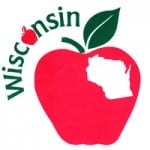 At the 2015 annual conference of the Wisconsin Apple Growers Association, Chuck Maenner – one of the conference organizers – took a bite out of an apple and grimaced with disgust. It was the most unpalatable apple he’d ever tasted! “Nobody would eat that,” he loudly proclaimed. Dan Bussey and Herdie Baisden smiled, because this was exactly the kind of reaction they’d hoped for!
At the 2015 annual conference of the Wisconsin Apple Growers Association, Chuck Maenner – one of the conference organizers – took a bite out of an apple and grimaced with disgust. It was the most unpalatable apple he’d ever tasted! “Nobody would eat that,” he loudly proclaimed. Dan Bussey and Herdie Baisden smiled, because this was exactly the kind of reaction they’d hoped for!
Chuck had taken a bite out of a Kronebusch apple, a bittersweet cider apple discovered by Gary Smith at an unnamed location in Minnesota; and introduced to cidermakers by Dan Bussey. Bussey, an apple historian and founder of a repository for apple germplasm, has recently published a compendium of over 14,000 apple varieties across seven volumes. When Baisden contacted Bussey to see if he had found any cider apples in his collection, he was delightfully surprised. Bussey introduced the Kronebusch apple and provided samples to Charles McGonegal to run some tests. McGonegal, a chemist by profession and a commercial cider maker at AEppelTreow Winery & Distillery in Burlington, WI, ran some tests and confirmed that the Kronebusch is a bittersweet apple suitable for blending in making quality hard cider.
Baisden, a cider maker at Maiden Rock Winery & Cidery in Stockholm, WI, along with other cider makers are in search of North American cider apples in general, and specifically in search of cider apples that are local to Wisconsin and surrounding areas. “So many of the cider-specific apples used in making hard cider these days were discovered or developed in Europe – especially in the UK, France, and Spain”, Baisden says. “Yet, there were some cider-specific varieties of apples that grew up in North America!”
Apple cider has quite a history in the United States. The first apple trees made it to Boston in 1623 and they were widely planted by the early 1800’s. Cider, hard cider in those days, was a drink from the old country that quickly established itself here in the 18th and 19th centuries. Before the development of preservative techniques, fresh cider rapidly and naturally fermented into hard cider. This was considered a way to “store” your apples being thought of as a safe, family drink. In fact, cider was regarded as safer than drinking water, due to the lack of effective water treatment. In the mid-1800’s, cider production began to decline due in part to urbanization, the introduction of beer and the temperance movement. In 1899, 55 million gallons were produced which by 1915 or so was down to 13 million gallons; and then in 1919, production declined even further as prohibition was the law of the land. Since the apple varieties used to make hard cider were not suitable as eating apples, many orchards converted to sweeter cultivars, actually taking out their cider trees. True cider apples are like the ‘wine grapes’ of apples; they contain tannins and acids that add mouth feel and complexity to a fermented beverage. When prohibition ended, the damage was irreversible to the hard cider industry, as the trees were gone and new plantings would take years to establish. Much of the hard cider produced today uses dessert apple juice, because the cidermakers are unable to find anything better. “That approach is like making wine from the table grapes you find in the grocery store, “ Baisden laments. “But the quest is on to re-discover some of the true cider apples previously grown in our area.”
Supported by a USDA Specialty Crop Block Grant through the Wisconsin Department of Trade and Consumer Protection (DATCP), the Wisconsin Apple Growers Association is championing a multifaceted campaign to jump-start Wisconsin’s fresh and hard cider industry and establish Wisconsin as a key region to supply the raw materials, i.e., cider-specific apples needed to make quality cider. Herdie Baisden, Program Manager for the Cider Project addressed a group of growers at a session held on Monday January 26 in Wisconsin Dells. With the market for hard cider continuing to grow, there are more and more cideries springing up around the country – all faced with the same dilemma: Where to get the raw materials (apples) they need to produce a quality hard cider? In addition to establishing a research plot at the Peninsula Agricultural Research Station (PARS) and running field trials, efforts include plundering plantings of seedlings in various parts of the state and asking people if they have any bitter apples growing at their farmstead or nearby. Like the Kronebusch, it might not be good for eating, but could be a great cider apple!


Leave a Reply